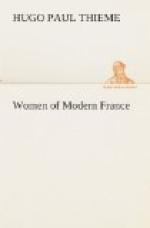Her love for La Rochefoucauld was the secret of her failure in life. When she experienced the disappointments of her married life and discovered that her dream of being loved by her husband could not be realized, she looked to other sources for diversion. She was not an intriguing woman like Mme. de Chevreuse, but one of ambitions which were incited by her love for and interest in the objects of her affection. Although she carried on flirtations with Coligny and the Duke of Nemours, she really loved no one but La Rochefoucauld, to whom she sacrificed her reputation and tranquillity, her duties and interests. For him she took up the cause of the Fronde; for him she was a mere slave, her entire existence being given up to his love, his whims, his service; when he failed her, she was lost, exhausted, and retired to a convent at the age of thirty-five and in the full bloom of her beauty. Her professed lover simply used her as a means to an end, seeking only his own interests in the Fronde, while she sought his; and this is the explanation of her seeming inconsistency of conduct. In her religious life she was happy and contented; surrounded by her friends, she lived peacefully for over twenty years.
Thus, Marie de’ Medici, a foreigner, Mme. de Chevreuse, and Mme. de Longueville represent the political women of the first half of the seventeenth century; Anne of Austria, who was of foreign extraction, was a mere tool in the hands of Mazarin, and exerted little influence in general.
One of the principal differences between the conspicuous political women of the sixteenth and those of the seventeenth centuries lies in the possession by the latter of less personal force than that wielded by the former, who allowed nothing to thwart their plans. The women of both periods were beautiful, but those of the earlier one were of a magnetic and sensual type, “inspiring insensate passions and exciting a feverish unrest,” thus ruling man through his lower instincts. The lack of refinement, sympathy, and charity reflected in their actions is in glaring contrast to the dignity, repose, reserve, and womanly modesty and grace displayed by their less masterful successors of the seventeenth century.
Chapter IV
Woman in Society and Literature
At the beginning of the seventeenth century, after the death of Henry IV., there were three classes in France,—the nobility, clergy, and third estate,—each with a distinct field of action: the nobility dominated customs, morality, and the government; the clergy supervised instruction and education; the third estate furnished the funds, that is, its work made possible the operations of the other classes.




